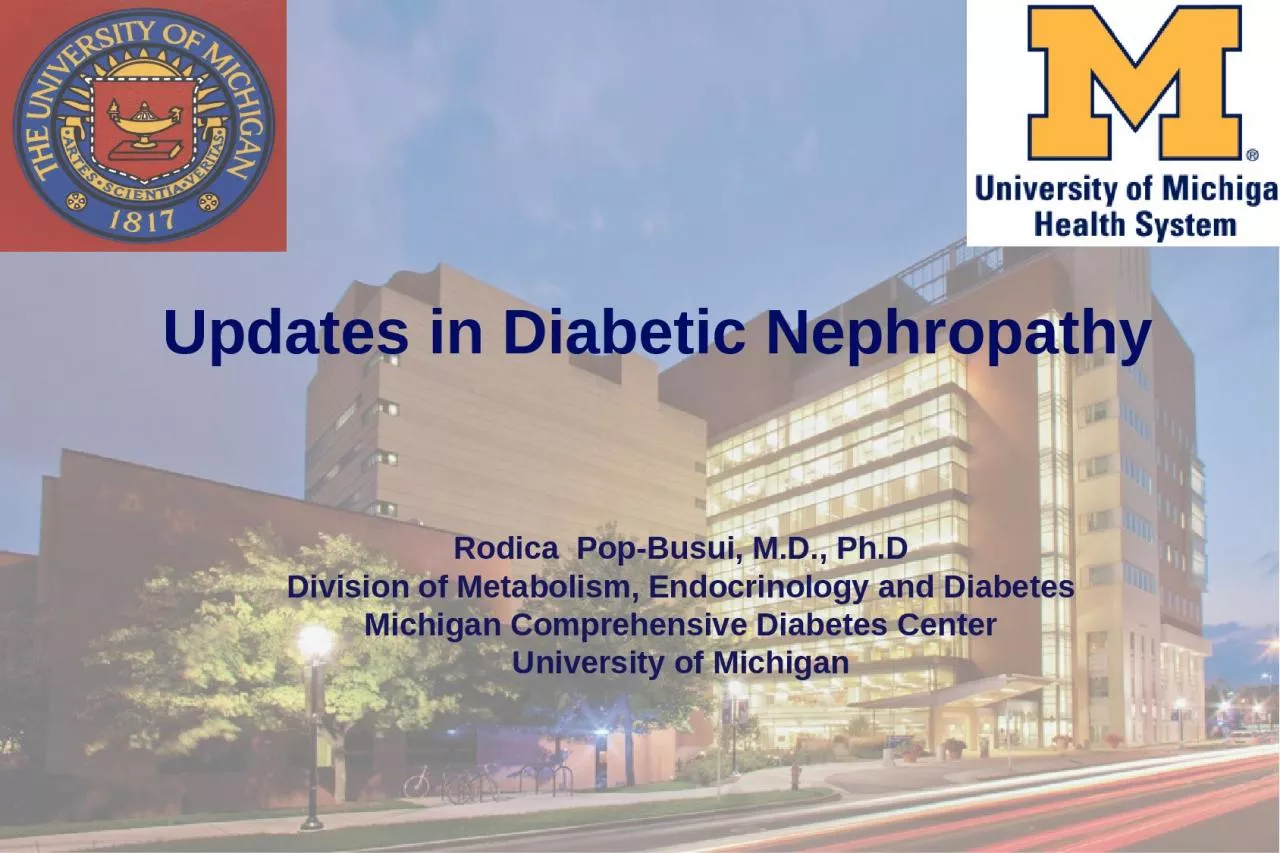

Rodica Pop Busui MD PhD Division of Metabolism Endocrinology and Diabetes Michigan Comprehensive Diabetes Center University of Michigan Diabetes is the dominant cause of ESRD in USA ID: 998780
Download Presentation The PPT/PDF document "Updates in Diabetic Nephropathy" is the property of its rightful owner. Permission is granted to download and print the materials on this web site for personal, non-commercial use only, and to display it on your personal computer provided you do not modify the materials and that you retain all copyright notices contained in the materials. By downloading content from our website, you accept the terms of this agreement.
1. Updates in Diabetic NephropathyRodica Pop-Busui, M.D., Ph.DDivision of Metabolism, Endocrinology and DiabetesMichigan Comprehensive Diabetes CenterUniversity of Michigan
2. Diabetes is the dominant cause of ESRD in USAUSRDS 2013Incident ESRD patients; rates adjusted for age, gender, & race.
3.
4.
5. RASS Group5Number of new cases USRDS 2008Incidence of ESRD Among Patients with Type 1 Diabetes-100-250+1600Overall a greater than 35% increase in ESRD in T1D in the USA in the last 25 yearsRosolowsky, Krolewski, et al, JASN 22:545, 2011
6. Pathology of diabetic nephropathyNormal GlomerulusEarly Diabetic GlomerulusCapillary lumenMesangial cellThickened BMExpanded mesangiumMesangiumPodocyte damage & lossBasement membrane– Afferent and efferent hyaline arteriolosclerosis– Interstitial fibrosis and tubular atrophy
7. Progression of diabetic nephropathyfrom T. HostetterRenal preglomerular vasodilationSystemic hypertensionGlomerular hypertensionHyperglycemiaGenetic factorsOx stressInflammationGlomerular sclerosis and tubulointerstitial fibrosis
8.
9.
10.
11. Current strategies to prevent kidney function loss on in diabetesIntensive glycemic controlDCCT, NEJM 1993N Engl J Med. 2011 Dec 22;365(25):2366DCCTNephropathy Incidence during EDIC= Metabolic memory
12.
13.
14. Current strategies to prevent kidney function loss on in diabetesRAAS InhibitionLewis et al, NEJM 1993
15. Limits of RAAS inhibitors in preventing kidney function loss in diabetes From Lewis et al, NEJM 1993GFR ≤50-60 ml/minGFR >50-60 ml/min
16. Prevention of nephropathyACEIs vs. ARBs???“Early blockade of the renin-angiotensin system in patients with type 1 diabetes did not slow nephropathy progression but slowed the progression of retinopathy.” RASS StudyN Engl J Med. 2009 Jul 2;361(1):40-51.
17. Treatment of diabetic nephropathy:Effect of ACEIs PLUS ARBsNow we know for sure
18. Perkins, et al. J Am Soc Nephrol 2007; 18:1353–1361.DN progression, decline in GFR, without development of albuminuria in T1 and T2 DN
19. Kidney International (2012) 82, 1010–1017DN pathology precedes clinical disease
20. Serum uric acid predicts CKD risk in the general populationAdapted from Domrongkitchaiporn et al, JASN 2005 Adjusted Odds Ratio of CKD ≤3Q1(1.50-4.49)Q2(4.50-5.39)Q3(5.40-6.29)Q4(6.30-14.50)(Ref.)Baseline Serum Uric Acid (mg/dl)n=3,49912-year follow-up
21. Steno Diabetes Center T1D inception cohort n=270 18-yr follow-up Outcome: MacroalbuminuriaHovind et al. Diabetes 2009Serum uric acid predicts albuminuriain the type 1 diabetic population
22. Serum uric acid predicts GFR loss in the type 1 diabetic population Joslin Kidney Study (n=355) T1D Natural History cohort Baseline GFR >60 ml/min/1.73m2 6-yr follow-up Outcome: GFR loss (>3.3%/yr)Ficociello et al. Diabetes Care 2010
23. Serum uric acid predicts CKD in the type 2 diabetic population Verona Diabetes Study (n=1,449) T2D, no proteinuria, GFR ≥60 ml/min/1.73 m2 5-yr follow-up Outcome: CKD (GFR <60 ml/min/1.73 m2 or proteinuria), n=194Zoppini et al. Diabetes Care 2012
24.
25.
26.
27.